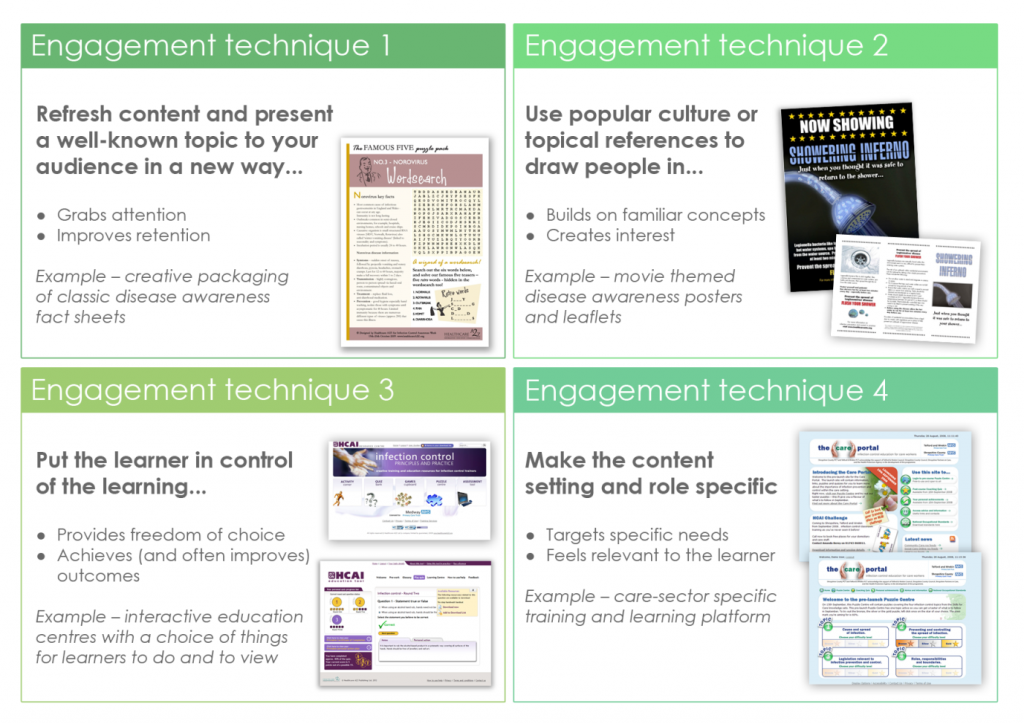Abstract:
Health education has been around for a long time. There are tried and trusted teaching and education techniques, based on traditional pedagogy, which have worked, and continue to work, in improving the health of individuals and communities. Times are changing though, and with the information revolution and social media domination, health education needs to work that little bit harder to make its presence felt. Who knows where this current revolution will lead us and how much content we will continue to generate. For health educators, this presents an exciting and interesting challenge, where it is time to hold on to our heritage, whilst embracing the need to change, and to get creative.
Main Article:
It really is true. There is no business like show business, or perhaps in a world now over-run with content, there is no business without show business. For those of us that work in health education, times have changed and using the power of engagement to get our message to land is key. The things that once worked for us have to be revisited and reinvented with a little bit of entertainment magic. Actually, it isn’t really about entertainment, it’s all about engagement!
Engagement and enthusiasm
So, what does engagement theory tell us? There are many complex engagement models and frameworks, but I like this simple equation:
expectation + experience = engagement
If we can anticipate what people want, and then give them an experience that makes them feel good, then we’re in the right place to create real engagement with our topic.
What we are actually talking about here is how to motivate people to do something; and, in the case of health education, that means moving people towards awareness, understanding and a change of behaviour. As educators, our goal is always to create the right outcome.
For this to happen, the challenge we have to overcome is the wealth of content available today. It feels like freedom of choice, but it has created a huge wall of noise that we have to work harder to break through. This is where the entertainment factor comes in. We’re looking to create enthusiasm – and when engagement really works – a ‘buzz’ where people want to tell and share with others too.
Imagination is more important than knowledge
Einstein said it first. Think about what captures your imagination. Which popular culture references do you know so well that recognising them is effortless? How do you respond to comforting images from your childhood? What makes you laugh? What stirs your emotions? What allows you to step outside of the real world? What matters to you in your daily role?
In infection prevention and control education, we have used different engagement techniques over the years. Different things work for different audiences, so although we apply some basic principles, it’s important to know your audience and tailor your education too.

Advertisers and promoters have known for decades
that generating emotion is key to engagement.Health educators are now recognising
and using these techniques too.
Three-steps to successful health education
Over the years, having worked across many communication, marketing, learning and education roles, I have settled on a simple three-step approach to designing engaging health education.
Step one: Create a universally recognised format
A well-known format will give your message room to breathe, as your audience doesn’t have to put in extra effort to understand a new concept. Plus, with something familiar (which stirs the right emotions) you are more likely to be noticed.
Step two: Capture your audience’s attention
Use different media, make sure your images have impact, use compelling copy, invite involvement and tie everything together to make it an enjoyable (and entertaining) experience for people.
Step three: Deliver high-quality education
Steps one and two are the show biz glitter, but it’s the backstage production that makes the show a success. Be clever with your concept, but, equally, be knowledgeable about your evidence base and confident in your educational content.
Putting the theory into practice
One example of how we have recently brought these three elements together to create a health education programme is the Pick of the Parasites campaign.

Pick of the Parasites is a Top 10 video countdown devoted to ten parasites that have made a real impact on our lives, and that continue to share our world (and our bodies). The campaign uses engaging, entertaining education to raise awareness of the facts about common parasitic infections from the last decade.
For step one, we chose the well-known ‘Top 10’ countdown format used in pop charts around the world. Something that everyone should recognise instantly.
For step two, we designed album covers for visual impact, parodied song lyrics for YouTube videos, invited participation and involvement, and co-ordinated everything across our web and social media platforms.
For step three, we partnered with Jason ‘Germ Guy’ Tetro, a renowned microbiologist, author and advocate for the power of entertainment in education; in addition to using qualified medical writers and a physician to review our content.
There is no business without show business
American Comedian, Steve Martin, once said, “Be so good they can’t ignore you”. It’s easy to be ignored or overlooked in our content rich world, but by conjuring up a little show business we can sparkle a bit and hopefully stand out from the crowd.
Pick of the Parasites is open to all
To view the video countdown visit the YouTube page here: https://www.youtube.com/channel/UCuzUBbDLp7pRoxDFn-pvtEg












